"Starry starry night,
paint your palette blue and gray. Look out on a summer's day
with eyes that know the darkness in my soul..."
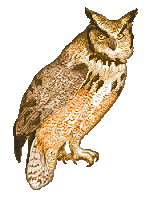 If you should venture out in the summer night you might very well see creatures that only make their appearance after dark. The Great Horned Owl (Bubo virginianus) is hard to spot but easy to hear it's call at night, especially early on towards dawn. It is found throughout the Americas and at 25 inches with a 55 inch wingspan is only exceeded in size by the Great Gray Owl. This bird is a daring and adaptable species that will attack any medium-sized mammal or bird, including skunks. It is one of the first birds to breed, laying eggs as early as late January. It's call is low and sonorous, hoo, hoo-hooing; a comforting call in the night to me, but perhaps not to small mammals.
If you should venture out in the summer night you might very well see creatures that only make their appearance after dark. The Great Horned Owl (Bubo virginianus) is hard to spot but easy to hear it's call at night, especially early on towards dawn. It is found throughout the Americas and at 25 inches with a 55 inch wingspan is only exceeded in size by the Great Gray Owl. This bird is a daring and adaptable species that will attack any medium-sized mammal or bird, including skunks. It is one of the first birds to breed, laying eggs as early as late January. It's call is low and sonorous, hoo, hoo-hooing; a comforting call in the night to me, but perhaps not to small mammals.
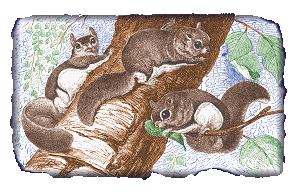 Southern Flying Squirrels (Glaucomys volans) are the smallest of the tree squirrels and the only nocturnal ones, as the large black eyes could probably have told you. They are only 8 1/4 to 10 inches long including the tail. And that wonderful tail acts as a rudder, since they don't truly fly, but glide through the forest. Its wide skin flaps on its side acts as a sort of parachute to slow its descent. They become airborne by leaping into the night and spreading its legs to glide down as far as 80 yards away. One summer we had a family nest in the birdhouse that hung on the side of a tree. You could hear them arise after dark and run squeaking up and down the trees. They would eat some of the corn off the squirrel feeder, and I even saw one glide from tree to tree. It was a truly rare thing to witness.
Southern Flying Squirrels (Glaucomys volans) are the smallest of the tree squirrels and the only nocturnal ones, as the large black eyes could probably have told you. They are only 8 1/4 to 10 inches long including the tail. And that wonderful tail acts as a rudder, since they don't truly fly, but glide through the forest. Its wide skin flaps on its side acts as a sort of parachute to slow its descent. They become airborne by leaping into the night and spreading its legs to glide down as far as 80 yards away. One summer we had a family nest in the birdhouse that hung on the side of a tree. You could hear them arise after dark and run squeaking up and down the trees. They would eat some of the corn off the squirrel feeder, and I even saw one glide from tree to tree. It was a truly rare thing to witness.
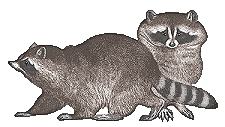 The masked nightly visitor, the raccoon (Procyon lotor), is a very easy animal to identify. That bushy striped tail and inquisitive mind, makes him come to the house every night here. He is about 23 to 38 inches long and native only to the Americas. Raccoons are solitary except when breeding and caring for their young. We have a large male visit alone every night, and in a separate visit, a mother with 3 little raccoons. They all are attracted by the seed, nuts, and suet that we put out for the birds. And though we don't mind sharing, I wish they would leave the suet alone, because they will eat it all and take the suet basket with them. We now have rigged up the basket so that it is inaccessible to raccoons and me alike, so my husband has to refill it. The baby raccoon visitors are very playful, we have a tub of water for them on the deck and they play and drink from it nightly. Momma raccoon carefully watches over their playful antics for danger, like when our cat, Ginger, growled at a baby who came up to the glass door. He ran for his mama, even though he was in no danger since Ginger was inside the house. Here is a picture of a late afternoon visit of mama raccoon and one of the babies.
The masked nightly visitor, the raccoon (Procyon lotor), is a very easy animal to identify. That bushy striped tail and inquisitive mind, makes him come to the house every night here. He is about 23 to 38 inches long and native only to the Americas. Raccoons are solitary except when breeding and caring for their young. We have a large male visit alone every night, and in a separate visit, a mother with 3 little raccoons. They all are attracted by the seed, nuts, and suet that we put out for the birds. And though we don't mind sharing, I wish they would leave the suet alone, because they will eat it all and take the suet basket with them. We now have rigged up the basket so that it is inaccessible to raccoons and me alike, so my husband has to refill it. The baby raccoon visitors are very playful, we have a tub of water for them on the deck and they play and drink from it nightly. Momma raccoon carefully watches over their playful antics for danger, like when our cat, Ginger, growled at a baby who came up to the glass door. He ran for his mama, even though he was in no danger since Ginger was inside the house. Here is a picture of a late afternoon visit of mama raccoon and one of the babies.
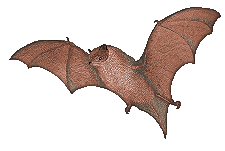 Winging through the night air is the Little Brown Bat (Myotis lucifugus), a benevolent insect eater, especially of mosquitoes. They are only 3 to 4 1/2 inches long with a wingspan of 8 to 10 inches, and the most abundant bat in North America. Bats in flight are hard to identify, but in this area the Little Brown Bat is the most likely one you will see. They usually give birth to one baby at a time, while hanging upside down, after which the baby will cling to its mother's belly until it learns to fly. Thousands may sleep together on a summer's day, but all will be females and their young. Males roost as solitary individuals. They are so helpful in taking care of the insect population, that you should encourage them to nest or, at the very least, leave them alone if they nest near your home.
Winging through the night air is the Little Brown Bat (Myotis lucifugus), a benevolent insect eater, especially of mosquitoes. They are only 3 to 4 1/2 inches long with a wingspan of 8 to 10 inches, and the most abundant bat in North America. Bats in flight are hard to identify, but in this area the Little Brown Bat is the most likely one you will see. They usually give birth to one baby at a time, while hanging upside down, after which the baby will cling to its mother's belly until it learns to fly. Thousands may sleep together on a summer's day, but all will be females and their young. Males roost as solitary individuals. They are so helpful in taking care of the insect population, that you should encourage them to nest or, at the very least, leave them alone if they nest near your home.
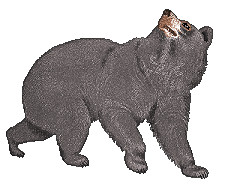 By far the largest nighttime visitor is the Black Bear (Ursus americanus). Here in the eastern United States they are almost entirely black in color with a tan snout. The black bear is 4 1/2 to 6 1/4 feet long with a shoulder height of 2 to 4 feet. Though they may not seem to be quick, they can climb to the top of a tree faster than you could run the same distance on the ground. They also can reach bursts of speed of 30 miles per hour. So don't even try to outrun them. Though they are considered nocturnal, they visit at anytime of the day or night. We even had one almost come in the house in the middle of the afternoon, he was attracted to the smell of food and it was a very bad year for mast (their food). Black bears, in the summer, are very attracted to sleeping nightly in the spotted touch-me-nots in front of my house. So I tend to not wander outside too much after dark, or at least make a lot of noise when I do. It lets them know I am there and they mostly will leave. They mate from June to early July and cubs (usually twins or triplets) are born January to early February. So spring to summer is when you will start seeing mothers and cubs. We had a mother bear wander through with her 3 cubs once. They were a lot of fun to watch from the inside of the house. They practiced their climbing skills while mom dozed at the base of the tree. It was a very special moment.
By far the largest nighttime visitor is the Black Bear (Ursus americanus). Here in the eastern United States they are almost entirely black in color with a tan snout. The black bear is 4 1/2 to 6 1/4 feet long with a shoulder height of 2 to 4 feet. Though they may not seem to be quick, they can climb to the top of a tree faster than you could run the same distance on the ground. They also can reach bursts of speed of 30 miles per hour. So don't even try to outrun them. Though they are considered nocturnal, they visit at anytime of the day or night. We even had one almost come in the house in the middle of the afternoon, he was attracted to the smell of food and it was a very bad year for mast (their food). Black bears, in the summer, are very attracted to sleeping nightly in the spotted touch-me-nots in front of my house. So I tend to not wander outside too much after dark, or at least make a lot of noise when I do. It lets them know I am there and they mostly will leave. They mate from June to early July and cubs (usually twins or triplets) are born January to early February. So spring to summer is when you will start seeing mothers and cubs. We had a mother bear wander through with her 3 cubs once. They were a lot of fun to watch from the inside of the house. They practiced their climbing skills while mom dozed at the base of the tree. It was a very special moment.
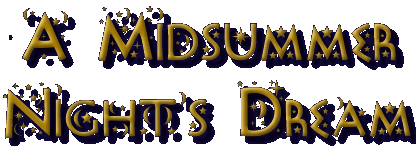
 If you should venture out in the summer night you might very well see creatures that only make their appearance after dark. The Great Horned Owl (Bubo virginianus) is hard to spot but easy to hear it's call at night, especially early on towards dawn. It is found throughout the Americas and at 25 inches with a 55 inch wingspan is only exceeded in size by the Great Gray Owl. This bird is a daring and adaptable species that will attack any medium-sized mammal or bird, including skunks. It is one of the first birds to breed, laying eggs as early as late January. It's call is low and sonorous, hoo, hoo-hooing; a comforting call in the night to me, but perhaps not to small mammals.
If you should venture out in the summer night you might very well see creatures that only make their appearance after dark. The Great Horned Owl (Bubo virginianus) is hard to spot but easy to hear it's call at night, especially early on towards dawn. It is found throughout the Americas and at 25 inches with a 55 inch wingspan is only exceeded in size by the Great Gray Owl. This bird is a daring and adaptable species that will attack any medium-sized mammal or bird, including skunks. It is one of the first birds to breed, laying eggs as early as late January. It's call is low and sonorous, hoo, hoo-hooing; a comforting call in the night to me, but perhaps not to small mammals. Southern Flying Squirrels (Glaucomys volans) are the smallest of the tree squirrels and the only nocturnal ones, as the large black eyes could probably have told you. They are only 8 1/4 to 10 inches long including the tail. And that wonderful tail acts as a rudder, since they don't truly fly, but glide through the forest. Its wide skin flaps on its side acts as a sort of parachute to slow its descent. They become airborne by leaping into the night and spreading its legs to glide down as far as 80 yards away. One summer we had a family nest in the birdhouse that hung on the side of a tree. You could hear them arise after dark and run squeaking up and down the trees. They would eat some of the corn off the squirrel feeder, and I even saw one glide from tree to tree. It was a truly rare thing to witness.
Southern Flying Squirrels (Glaucomys volans) are the smallest of the tree squirrels and the only nocturnal ones, as the large black eyes could probably have told you. They are only 8 1/4 to 10 inches long including the tail. And that wonderful tail acts as a rudder, since they don't truly fly, but glide through the forest. Its wide skin flaps on its side acts as a sort of parachute to slow its descent. They become airborne by leaping into the night and spreading its legs to glide down as far as 80 yards away. One summer we had a family nest in the birdhouse that hung on the side of a tree. You could hear them arise after dark and run squeaking up and down the trees. They would eat some of the corn off the squirrel feeder, and I even saw one glide from tree to tree. It was a truly rare thing to witness. The masked nightly visitor, the raccoon (Procyon lotor), is a very easy animal to identify. That bushy striped tail and inquisitive mind, makes him come to the house every night here. He is about 23 to 38 inches long and native only to the Americas. Raccoons are solitary except when breeding and caring for their young. We have a large male visit alone every night, and in a separate visit, a mother with 3 little raccoons. They all are attracted by the seed, nuts, and suet that we put out for the birds. And though we don't mind sharing, I wish they would leave the suet alone, because they will eat it all and take the suet basket with them. We now have rigged up the basket so that it is inaccessible to raccoons and me alike, so my husband has to refill it. The baby raccoon visitors are very playful, we have a tub of water for them on the deck and they play and drink from it nightly. Momma raccoon carefully watches over their playful antics for danger, like when our cat, Ginger, growled at a baby who came up to the glass door. He ran for his mama, even though he was in no danger since Ginger was inside the house. Here is a
The masked nightly visitor, the raccoon (Procyon lotor), is a very easy animal to identify. That bushy striped tail and inquisitive mind, makes him come to the house every night here. He is about 23 to 38 inches long and native only to the Americas. Raccoons are solitary except when breeding and caring for their young. We have a large male visit alone every night, and in a separate visit, a mother with 3 little raccoons. They all are attracted by the seed, nuts, and suet that we put out for the birds. And though we don't mind sharing, I wish they would leave the suet alone, because they will eat it all and take the suet basket with them. We now have rigged up the basket so that it is inaccessible to raccoons and me alike, so my husband has to refill it. The baby raccoon visitors are very playful, we have a tub of water for them on the deck and they play and drink from it nightly. Momma raccoon carefully watches over their playful antics for danger, like when our cat, Ginger, growled at a baby who came up to the glass door. He ran for his mama, even though he was in no danger since Ginger was inside the house. Here is a  Winging through the night air is the Little Brown Bat (Myotis lucifugus), a benevolent insect eater, especially of mosquitoes. They are only 3 to 4 1/2 inches long with a wingspan of 8 to 10 inches, and the most abundant bat in North America. Bats in flight are hard to identify, but in this area the Little Brown Bat is the most likely one you will see. They usually give birth to one baby at a time, while hanging upside down, after which the baby will cling to its mother's belly until it learns to fly. Thousands may sleep together on a summer's day, but all will be females and their young. Males roost as solitary individuals. They are so helpful in taking care of the insect population, that you should encourage them to nest or, at the very least, leave them alone if they nest near your home.
Winging through the night air is the Little Brown Bat (Myotis lucifugus), a benevolent insect eater, especially of mosquitoes. They are only 3 to 4 1/2 inches long with a wingspan of 8 to 10 inches, and the most abundant bat in North America. Bats in flight are hard to identify, but in this area the Little Brown Bat is the most likely one you will see. They usually give birth to one baby at a time, while hanging upside down, after which the baby will cling to its mother's belly until it learns to fly. Thousands may sleep together on a summer's day, but all will be females and their young. Males roost as solitary individuals. They are so helpful in taking care of the insect population, that you should encourage them to nest or, at the very least, leave them alone if they nest near your home.
 By far the largest nighttime visitor is the Black Bear (Ursus americanus). Here in the eastern United States they are almost entirely black in color with a tan snout. The black bear is 4 1/2 to 6 1/4 feet long with a shoulder height of 2 to 4 feet. Though they may not seem to be quick, they can climb to the top of a tree faster than you could run the same distance on the ground. They also can reach bursts of speed of 30 miles per hour. So don't even try to outrun them. Though they are considered nocturnal, they visit at anytime of the day or night. We even had one almost come in the house in the middle of the afternoon, he was attracted to the smell of food and it was a very bad year for mast (their food). Black bears, in the summer, are very attracted to sleeping nightly in the spotted touch-me-nots in front of my house. So I tend to not wander outside too much after dark, or at least make a lot of noise when I do. It lets them know I am there and they mostly will leave. They mate from June to early July and cubs (usually twins or triplets) are born January to early February. So spring to summer is when you will start seeing mothers and cubs. We had a mother bear wander through with her 3 cubs once. They were a lot of fun to watch from the inside of the house. They practiced their climbing skills while mom dozed at the base of the tree. It was a very special moment.
By far the largest nighttime visitor is the Black Bear (Ursus americanus). Here in the eastern United States they are almost entirely black in color with a tan snout. The black bear is 4 1/2 to 6 1/4 feet long with a shoulder height of 2 to 4 feet. Though they may not seem to be quick, they can climb to the top of a tree faster than you could run the same distance on the ground. They also can reach bursts of speed of 30 miles per hour. So don't even try to outrun them. Though they are considered nocturnal, they visit at anytime of the day or night. We even had one almost come in the house in the middle of the afternoon, he was attracted to the smell of food and it was a very bad year for mast (their food). Black bears, in the summer, are very attracted to sleeping nightly in the spotted touch-me-nots in front of my house. So I tend to not wander outside too much after dark, or at least make a lot of noise when I do. It lets them know I am there and they mostly will leave. They mate from June to early July and cubs (usually twins or triplets) are born January to early February. So spring to summer is when you will start seeing mothers and cubs. We had a mother bear wander through with her 3 cubs once. They were a lot of fun to watch from the inside of the house. They practiced their climbing skills while mom dozed at the base of the tree. It was a very special moment.